An Analysis of Positive Leadership, Employee Performance, and PsyCap
VerifiedAdded on 2022/09/21
|8
|2379
|17
Essay
AI Summary
This essay delves into the significance of authentic leadership in fostering a positive business environment. It examines the interconnectedness of authentic leadership, Leader-Member Exchange (LMX), and psychological capital (PsyCap), highlighting their combined effect on employee motivation and performance. The paper explores how authentic leaders utilize the LMX model and PsyCap to create effective working conditions, aligning employee interests with organizational objectives. It also discusses the PERMA model of happiness and the importance of tailoring PsyCap strategies to different employee groups. The essay emphasizes the impact of a leader's emotions on employee productivity, concluding that a positive environment, cultivated by the leader, is crucial for employee success. The essay provides a comprehensive overview of the relationship between leadership styles and employee performance, supported by academic references.
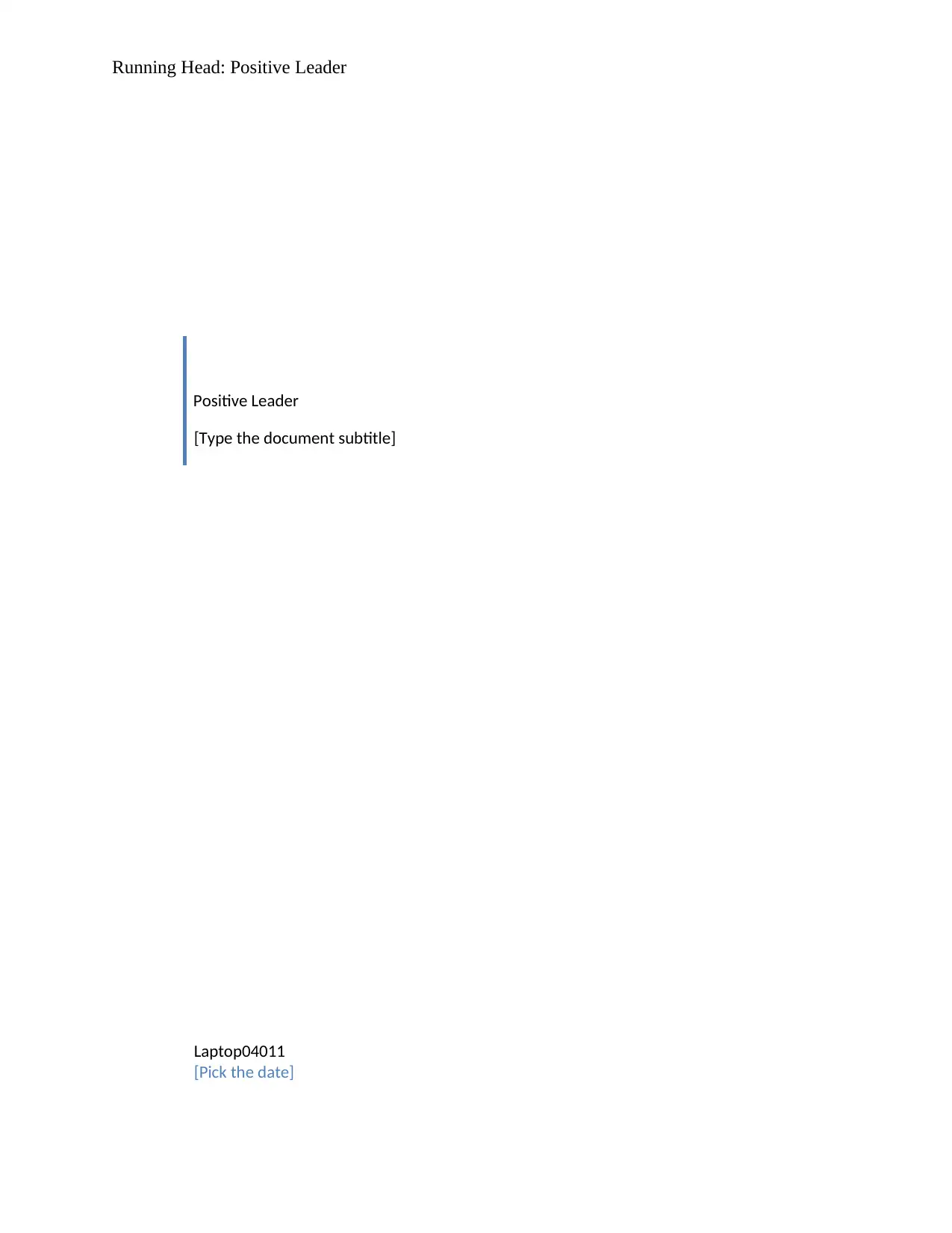
Running Head: Positive Leader
Positive Leader
[Type the document subtitle]
Laptop04011
[Pick the date]
Positive Leader
[Type the document subtitle]
Laptop04011
[Pick the date]
Paraphrase This Document
Need a fresh take? Get an instant paraphrase of this document with our AI Paraphraser
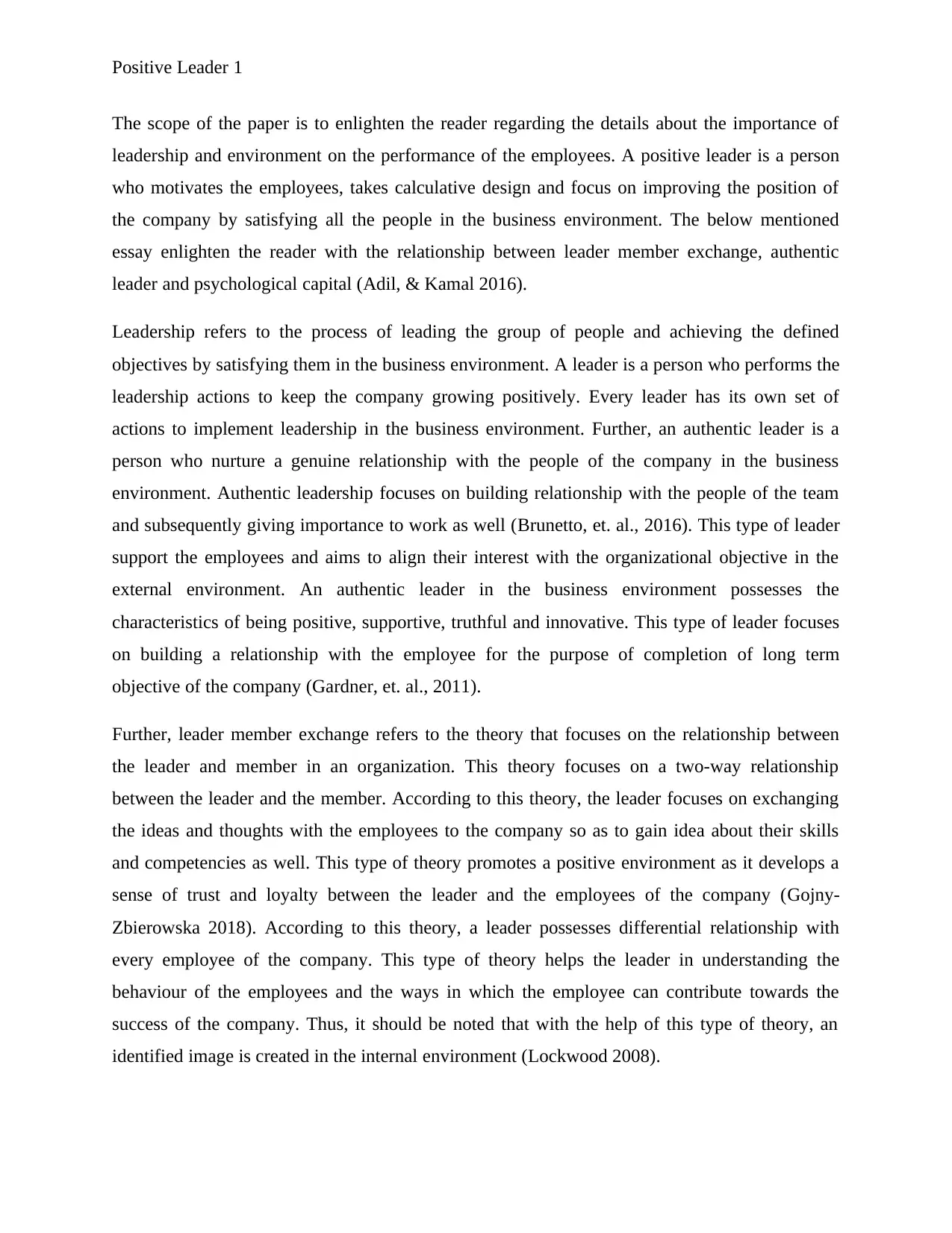
Positive Leader 1
The scope of the paper is to enlighten the reader regarding the details about the importance of
leadership and environment on the performance of the employees. A positive leader is a person
who motivates the employees, takes calculative design and focus on improving the position of
the company by satisfying all the people in the business environment. The below mentioned
essay enlighten the reader with the relationship between leader member exchange, authentic
leader and psychological capital (Adil, & Kamal 2016).
Leadership refers to the process of leading the group of people and achieving the defined
objectives by satisfying them in the business environment. A leader is a person who performs the
leadership actions to keep the company growing positively. Every leader has its own set of
actions to implement leadership in the business environment. Further, an authentic leader is a
person who nurture a genuine relationship with the people of the company in the business
environment. Authentic leadership focuses on building relationship with the people of the team
and subsequently giving importance to work as well (Brunetto, et. al., 2016). This type of leader
support the employees and aims to align their interest with the organizational objective in the
external environment. An authentic leader in the business environment possesses the
characteristics of being positive, supportive, truthful and innovative. This type of leader focuses
on building a relationship with the employee for the purpose of completion of long term
objective of the company (Gardner, et. al., 2011).
Further, leader member exchange refers to the theory that focuses on the relationship between
the leader and member in an organization. This theory focuses on a two-way relationship
between the leader and the member. According to this theory, the leader focuses on exchanging
the ideas and thoughts with the employees to the company so as to gain idea about their skills
and competencies as well. This type of theory promotes a positive environment as it develops a
sense of trust and loyalty between the leader and the employees of the company (Gojny-
Zbierowska 2018). According to this theory, a leader possesses differential relationship with
every employee of the company. This type of theory helps the leader in understanding the
behaviour of the employees and the ways in which the employee can contribute towards the
success of the company. Thus, it should be noted that with the help of this type of theory, an
identified image is created in the internal environment (Lockwood 2008).
The scope of the paper is to enlighten the reader regarding the details about the importance of
leadership and environment on the performance of the employees. A positive leader is a person
who motivates the employees, takes calculative design and focus on improving the position of
the company by satisfying all the people in the business environment. The below mentioned
essay enlighten the reader with the relationship between leader member exchange, authentic
leader and psychological capital (Adil, & Kamal 2016).
Leadership refers to the process of leading the group of people and achieving the defined
objectives by satisfying them in the business environment. A leader is a person who performs the
leadership actions to keep the company growing positively. Every leader has its own set of
actions to implement leadership in the business environment. Further, an authentic leader is a
person who nurture a genuine relationship with the people of the company in the business
environment. Authentic leadership focuses on building relationship with the people of the team
and subsequently giving importance to work as well (Brunetto, et. al., 2016). This type of leader
support the employees and aims to align their interest with the organizational objective in the
external environment. An authentic leader in the business environment possesses the
characteristics of being positive, supportive, truthful and innovative. This type of leader focuses
on building a relationship with the employee for the purpose of completion of long term
objective of the company (Gardner, et. al., 2011).
Further, leader member exchange refers to the theory that focuses on the relationship between
the leader and member in an organization. This theory focuses on a two-way relationship
between the leader and the member. According to this theory, the leader focuses on exchanging
the ideas and thoughts with the employees to the company so as to gain idea about their skills
and competencies as well. This type of theory promotes a positive environment as it develops a
sense of trust and loyalty between the leader and the employees of the company (Gojny-
Zbierowska 2018). According to this theory, a leader possesses differential relationship with
every employee of the company. This type of theory helps the leader in understanding the
behaviour of the employees and the ways in which the employee can contribute towards the
success of the company. Thus, it should be noted that with the help of this type of theory, an
identified image is created in the internal environment (Lockwood 2008).
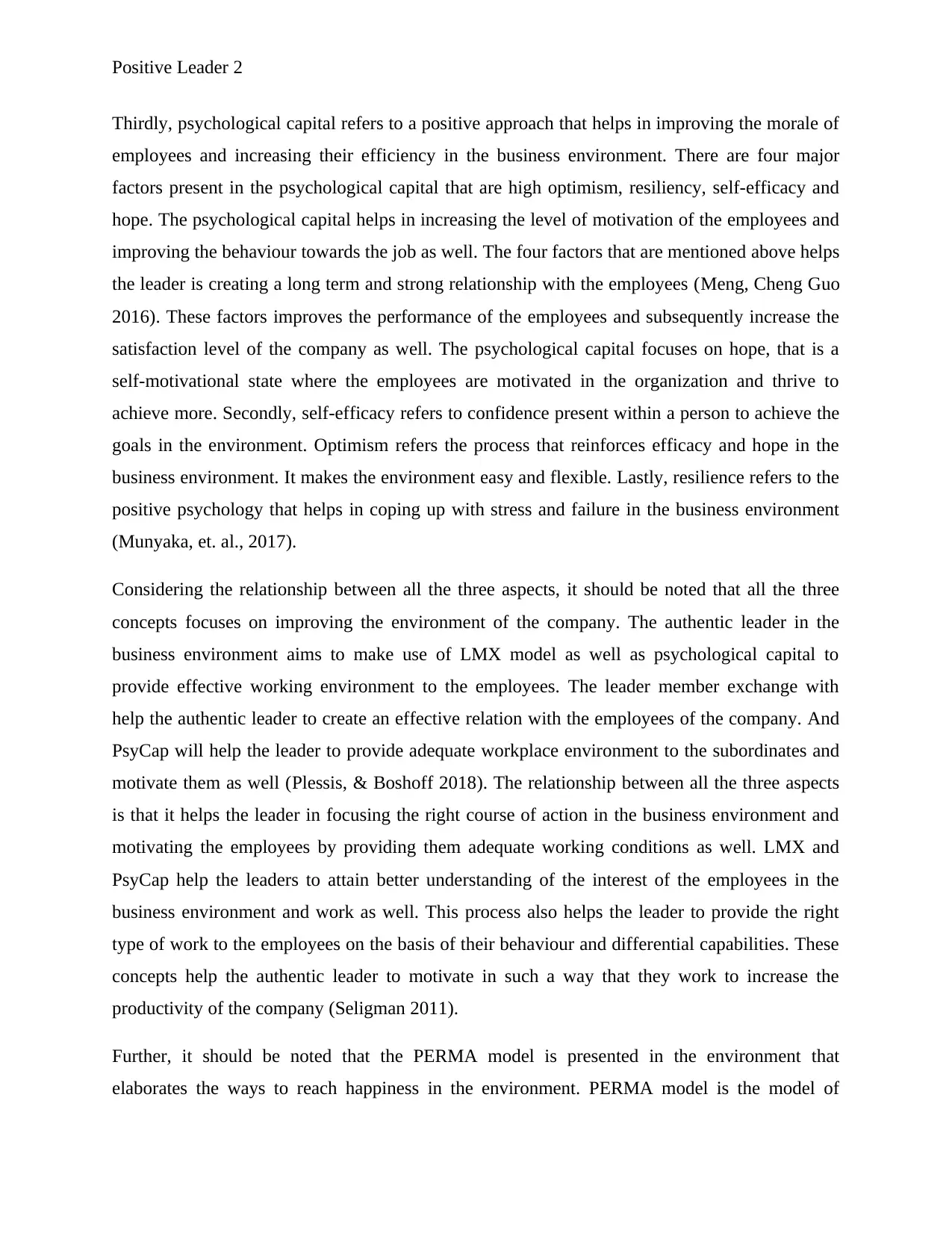
Positive Leader 2
Thirdly, psychological capital refers to a positive approach that helps in improving the morale of
employees and increasing their efficiency in the business environment. There are four major
factors present in the psychological capital that are high optimism, resiliency, self-efficacy and
hope. The psychological capital helps in increasing the level of motivation of the employees and
improving the behaviour towards the job as well. The four factors that are mentioned above helps
the leader is creating a long term and strong relationship with the employees (Meng, Cheng Guo
2016). These factors improves the performance of the employees and subsequently increase the
satisfaction level of the company as well. The psychological capital focuses on hope, that is a
self-motivational state where the employees are motivated in the organization and thrive to
achieve more. Secondly, self-efficacy refers to confidence present within a person to achieve the
goals in the environment. Optimism refers the process that reinforces efficacy and hope in the
business environment. It makes the environment easy and flexible. Lastly, resilience refers to the
positive psychology that helps in coping up with stress and failure in the business environment
(Munyaka, et. al., 2017).
Considering the relationship between all the three aspects, it should be noted that all the three
concepts focuses on improving the environment of the company. The authentic leader in the
business environment aims to make use of LMX model as well as psychological capital to
provide effective working environment to the employees. The leader member exchange with
help the authentic leader to create an effective relation with the employees of the company. And
PsyCap will help the leader to provide adequate workplace environment to the subordinates and
motivate them as well (Plessis, & Boshoff 2018). The relationship between all the three aspects
is that it helps the leader in focusing the right course of action in the business environment and
motivating the employees by providing them adequate working conditions as well. LMX and
PsyCap help the leaders to attain better understanding of the interest of the employees in the
business environment and work as well. This process also helps the leader to provide the right
type of work to the employees on the basis of their behaviour and differential capabilities. These
concepts help the authentic leader to motivate in such a way that they work to increase the
productivity of the company (Seligman 2011).
Further, it should be noted that the PERMA model is presented in the environment that
elaborates the ways to reach happiness in the environment. PERMA model is the model of
Thirdly, psychological capital refers to a positive approach that helps in improving the morale of
employees and increasing their efficiency in the business environment. There are four major
factors present in the psychological capital that are high optimism, resiliency, self-efficacy and
hope. The psychological capital helps in increasing the level of motivation of the employees and
improving the behaviour towards the job as well. The four factors that are mentioned above helps
the leader is creating a long term and strong relationship with the employees (Meng, Cheng Guo
2016). These factors improves the performance of the employees and subsequently increase the
satisfaction level of the company as well. The psychological capital focuses on hope, that is a
self-motivational state where the employees are motivated in the organization and thrive to
achieve more. Secondly, self-efficacy refers to confidence present within a person to achieve the
goals in the environment. Optimism refers the process that reinforces efficacy and hope in the
business environment. It makes the environment easy and flexible. Lastly, resilience refers to the
positive psychology that helps in coping up with stress and failure in the business environment
(Munyaka, et. al., 2017).
Considering the relationship between all the three aspects, it should be noted that all the three
concepts focuses on improving the environment of the company. The authentic leader in the
business environment aims to make use of LMX model as well as psychological capital to
provide effective working environment to the employees. The leader member exchange with
help the authentic leader to create an effective relation with the employees of the company. And
PsyCap will help the leader to provide adequate workplace environment to the subordinates and
motivate them as well (Plessis, & Boshoff 2018). The relationship between all the three aspects
is that it helps the leader in focusing the right course of action in the business environment and
motivating the employees by providing them adequate working conditions as well. LMX and
PsyCap help the leaders to attain better understanding of the interest of the employees in the
business environment and work as well. This process also helps the leader to provide the right
type of work to the employees on the basis of their behaviour and differential capabilities. These
concepts help the authentic leader to motivate in such a way that they work to increase the
productivity of the company (Seligman 2011).
Further, it should be noted that the PERMA model is presented in the environment that
elaborates the ways to reach happiness in the environment. PERMA model is the model of
⊘ This is a preview!⊘
Do you want full access?
Subscribe today to unlock all pages.

Trusted by 1+ million students worldwide
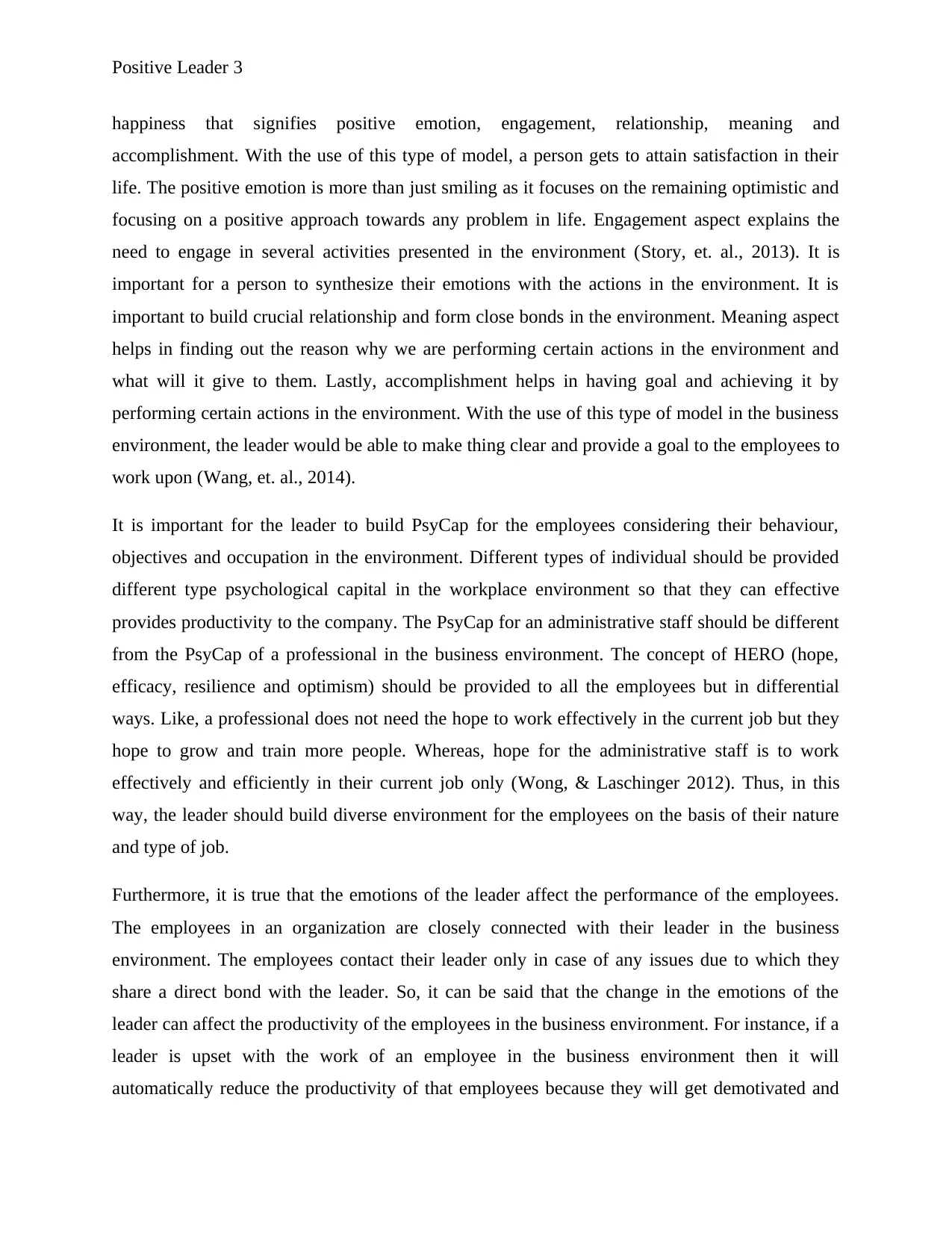
Positive Leader 3
happiness that signifies positive emotion, engagement, relationship, meaning and
accomplishment. With the use of this type of model, a person gets to attain satisfaction in their
life. The positive emotion is more than just smiling as it focuses on the remaining optimistic and
focusing on a positive approach towards any problem in life. Engagement aspect explains the
need to engage in several activities presented in the environment (Story, et. al., 2013). It is
important for a person to synthesize their emotions with the actions in the environment. It is
important to build crucial relationship and form close bonds in the environment. Meaning aspect
helps in finding out the reason why we are performing certain actions in the environment and
what will it give to them. Lastly, accomplishment helps in having goal and achieving it by
performing certain actions in the environment. With the use of this type of model in the business
environment, the leader would be able to make thing clear and provide a goal to the employees to
work upon (Wang, et. al., 2014).
It is important for the leader to build PsyCap for the employees considering their behaviour,
objectives and occupation in the environment. Different types of individual should be provided
different type psychological capital in the workplace environment so that they can effective
provides productivity to the company. The PsyCap for an administrative staff should be different
from the PsyCap of a professional in the business environment. The concept of HERO (hope,
efficacy, resilience and optimism) should be provided to all the employees but in differential
ways. Like, a professional does not need the hope to work effectively in the current job but they
hope to grow and train more people. Whereas, hope for the administrative staff is to work
effectively and efficiently in their current job only (Wong, & Laschinger 2012). Thus, in this
way, the leader should build diverse environment for the employees on the basis of their nature
and type of job.
Furthermore, it is true that the emotions of the leader affect the performance of the employees.
The employees in an organization are closely connected with their leader in the business
environment. The employees contact their leader only in case of any issues due to which they
share a direct bond with the leader. So, it can be said that the change in the emotions of the
leader can affect the productivity of the employees in the business environment. For instance, if a
leader is upset with the work of an employee in the business environment then it will
automatically reduce the productivity of that employees because they will get demotivated and
happiness that signifies positive emotion, engagement, relationship, meaning and
accomplishment. With the use of this type of model, a person gets to attain satisfaction in their
life. The positive emotion is more than just smiling as it focuses on the remaining optimistic and
focusing on a positive approach towards any problem in life. Engagement aspect explains the
need to engage in several activities presented in the environment (Story, et. al., 2013). It is
important for a person to synthesize their emotions with the actions in the environment. It is
important to build crucial relationship and form close bonds in the environment. Meaning aspect
helps in finding out the reason why we are performing certain actions in the environment and
what will it give to them. Lastly, accomplishment helps in having goal and achieving it by
performing certain actions in the environment. With the use of this type of model in the business
environment, the leader would be able to make thing clear and provide a goal to the employees to
work upon (Wang, et. al., 2014).
It is important for the leader to build PsyCap for the employees considering their behaviour,
objectives and occupation in the environment. Different types of individual should be provided
different type psychological capital in the workplace environment so that they can effective
provides productivity to the company. The PsyCap for an administrative staff should be different
from the PsyCap of a professional in the business environment. The concept of HERO (hope,
efficacy, resilience and optimism) should be provided to all the employees but in differential
ways. Like, a professional does not need the hope to work effectively in the current job but they
hope to grow and train more people. Whereas, hope for the administrative staff is to work
effectively and efficiently in their current job only (Wong, & Laschinger 2012). Thus, in this
way, the leader should build diverse environment for the employees on the basis of their nature
and type of job.
Furthermore, it is true that the emotions of the leader affect the performance of the employees.
The employees in an organization are closely connected with their leader in the business
environment. The employees contact their leader only in case of any issues due to which they
share a direct bond with the leader. So, it can be said that the change in the emotions of the
leader can affect the productivity of the employees in the business environment. For instance, if a
leader is upset with the work of an employee in the business environment then it will
automatically reduce the productivity of that employees because they will get demotivated and
Paraphrase This Document
Need a fresh take? Get an instant paraphrase of this document with our AI Paraphraser
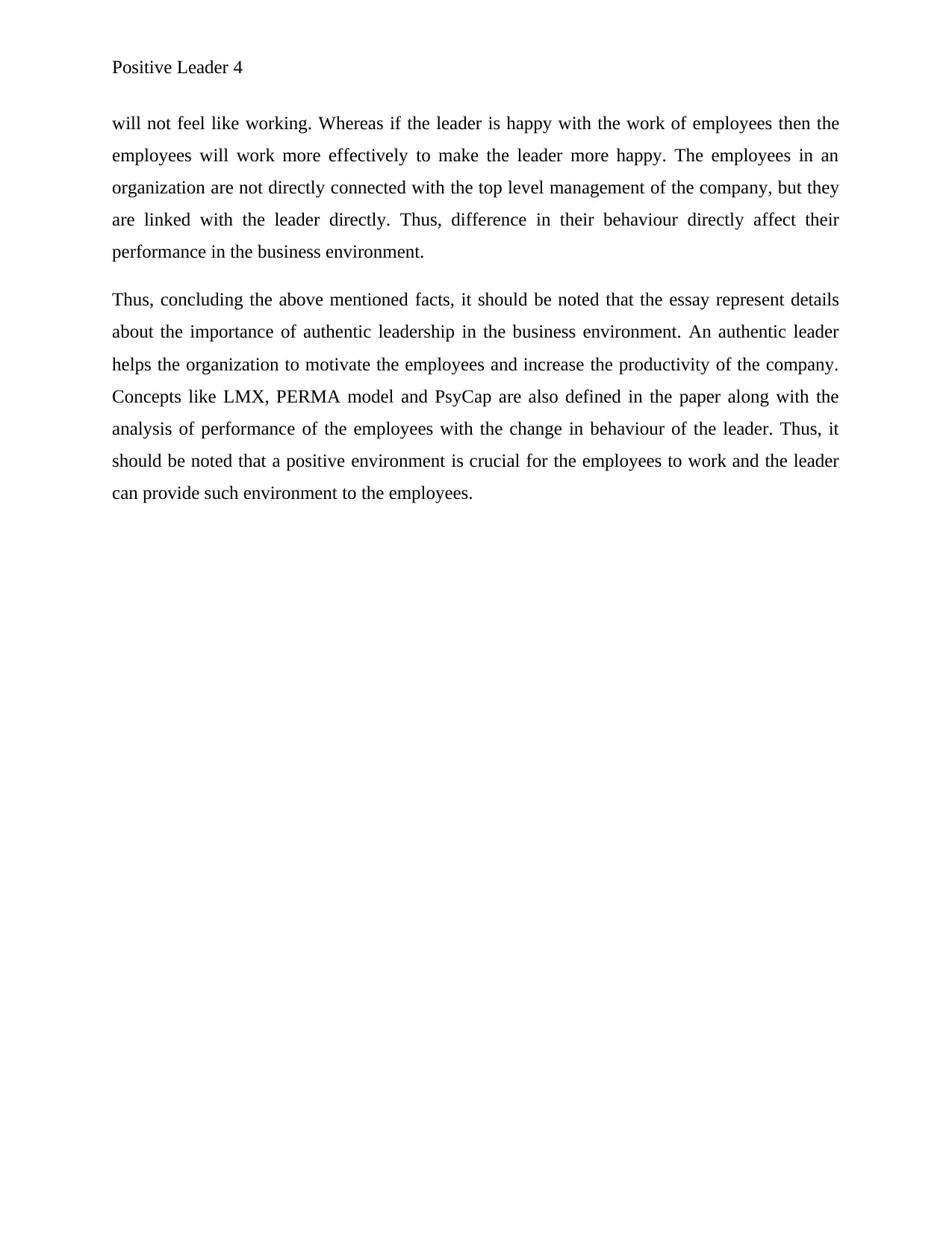
Positive Leader 4
will not feel like working. Whereas if the leader is happy with the work of employees then the
employees will work more effectively to make the leader more happy. The employees in an
organization are not directly connected with the top level management of the company, but they
are linked with the leader directly. Thus, difference in their behaviour directly affect their
performance in the business environment.
Thus, concluding the above mentioned facts, it should be noted that the essay represent details
about the importance of authentic leadership in the business environment. An authentic leader
helps the organization to motivate the employees and increase the productivity of the company.
Concepts like LMX, PERMA model and PsyCap are also defined in the paper along with the
analysis of performance of the employees with the change in behaviour of the leader. Thus, it
should be noted that a positive environment is crucial for the employees to work and the leader
can provide such environment to the employees.
will not feel like working. Whereas if the leader is happy with the work of employees then the
employees will work more effectively to make the leader more happy. The employees in an
organization are not directly connected with the top level management of the company, but they
are linked with the leader directly. Thus, difference in their behaviour directly affect their
performance in the business environment.
Thus, concluding the above mentioned facts, it should be noted that the essay represent details
about the importance of authentic leadership in the business environment. An authentic leader
helps the organization to motivate the employees and increase the productivity of the company.
Concepts like LMX, PERMA model and PsyCap are also defined in the paper along with the
analysis of performance of the employees with the change in behaviour of the leader. Thus, it
should be noted that a positive environment is crucial for the employees to work and the leader
can provide such environment to the employees.
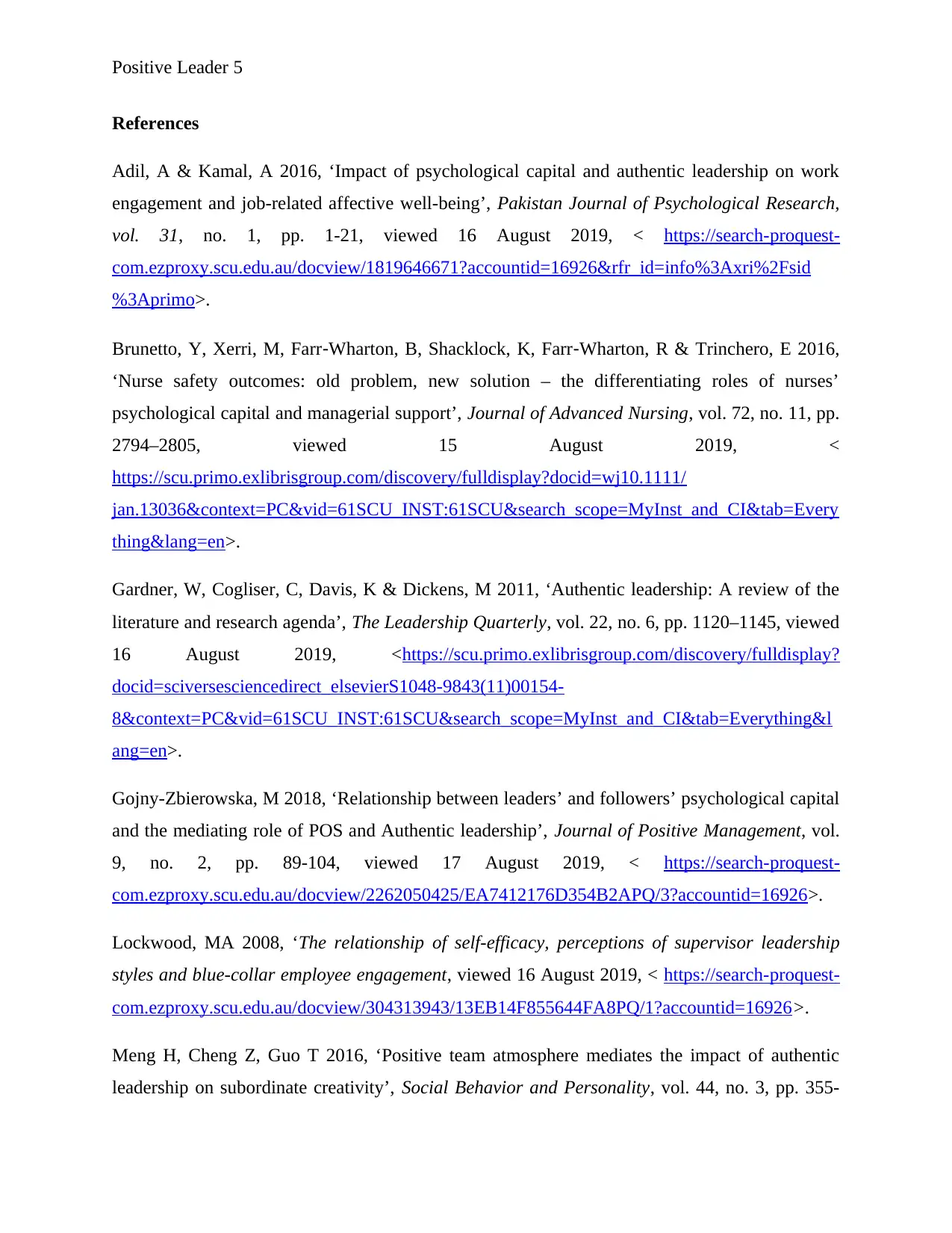
Positive Leader 5
References
Adil, A & Kamal, A 2016, ‘Impact of psychological capital and authentic leadership on work
engagement and job-related affective well-being’, Pakistan Journal of Psychological Research,
vol. 31, no. 1, pp. 1-21, viewed 16 August 2019, < https://search-proquest-
com.ezproxy.scu.edu.au/docview/1819646671?accountid=16926&rfr_id=info%3Axri%2Fsid
%3Aprimo>.
Brunetto, Y, Xerri, M, Farr‐Wharton, B, Shacklock, K, Farr‐Wharton, R & Trinchero, E 2016,
‘Nurse safety outcomes: old problem, new solution – the differentiating roles of nurses’
psychological capital and managerial support’, Journal of Advanced Nursing, vol. 72, no. 11, pp.
2794–2805, viewed 15 August 2019, <
https://scu.primo.exlibrisgroup.com/discovery/fulldisplay?docid=wj10.1111/
jan.13036&context=PC&vid=61SCU_INST:61SCU&search_scope=MyInst_and_CI&tab=Every
thing&lang=en>.
Gardner, W, Cogliser, C, Davis, K & Dickens, M 2011, ‘Authentic leadership: A review of the
literature and research agenda’, The Leadership Quarterly, vol. 22, no. 6, pp. 1120–1145, viewed
16 August 2019, <https://scu.primo.exlibrisgroup.com/discovery/fulldisplay?
docid=sciversesciencedirect_elsevierS1048-9843(11)00154-
8&context=PC&vid=61SCU_INST:61SCU&search_scope=MyInst_and_CI&tab=Everything&l
ang=en>.
Gojny-Zbierowska, M 2018, ‘Relationship between leaders’ and followers’ psychological capital
and the mediating role of POS and Authentic leadership’, Journal of Positive Management, vol.
9, no. 2, pp. 89-104, viewed 17 August 2019, < https://search-proquest-
com.ezproxy.scu.edu.au/docview/2262050425/EA7412176D354B2APQ/3?accountid=16926>.
Lockwood, MA 2008, ‘The relationship of self-efficacy, perceptions of supervisor leadership
styles and blue-collar employee engagement, viewed 16 August 2019, < https://search-proquest-
com.ezproxy.scu.edu.au/docview/304313943/13EB14F855644FA8PQ/1?accountid=16926>.
Meng H, Cheng Z, Guo T 2016, ‘Positive team atmosphere mediates the impact of authentic
leadership on subordinate creativity’, Social Behavior and Personality, vol. 44, no. 3, pp. 355-
References
Adil, A & Kamal, A 2016, ‘Impact of psychological capital and authentic leadership on work
engagement and job-related affective well-being’, Pakistan Journal of Psychological Research,
vol. 31, no. 1, pp. 1-21, viewed 16 August 2019, < https://search-proquest-
com.ezproxy.scu.edu.au/docview/1819646671?accountid=16926&rfr_id=info%3Axri%2Fsid
%3Aprimo>.
Brunetto, Y, Xerri, M, Farr‐Wharton, B, Shacklock, K, Farr‐Wharton, R & Trinchero, E 2016,
‘Nurse safety outcomes: old problem, new solution – the differentiating roles of nurses’
psychological capital and managerial support’, Journal of Advanced Nursing, vol. 72, no. 11, pp.
2794–2805, viewed 15 August 2019, <
https://scu.primo.exlibrisgroup.com/discovery/fulldisplay?docid=wj10.1111/
jan.13036&context=PC&vid=61SCU_INST:61SCU&search_scope=MyInst_and_CI&tab=Every
thing&lang=en>.
Gardner, W, Cogliser, C, Davis, K & Dickens, M 2011, ‘Authentic leadership: A review of the
literature and research agenda’, The Leadership Quarterly, vol. 22, no. 6, pp. 1120–1145, viewed
16 August 2019, <https://scu.primo.exlibrisgroup.com/discovery/fulldisplay?
docid=sciversesciencedirect_elsevierS1048-9843(11)00154-
8&context=PC&vid=61SCU_INST:61SCU&search_scope=MyInst_and_CI&tab=Everything&l
ang=en>.
Gojny-Zbierowska, M 2018, ‘Relationship between leaders’ and followers’ psychological capital
and the mediating role of POS and Authentic leadership’, Journal of Positive Management, vol.
9, no. 2, pp. 89-104, viewed 17 August 2019, < https://search-proquest-
com.ezproxy.scu.edu.au/docview/2262050425/EA7412176D354B2APQ/3?accountid=16926>.
Lockwood, MA 2008, ‘The relationship of self-efficacy, perceptions of supervisor leadership
styles and blue-collar employee engagement, viewed 16 August 2019, < https://search-proquest-
com.ezproxy.scu.edu.au/docview/304313943/13EB14F855644FA8PQ/1?accountid=16926>.
Meng H, Cheng Z, Guo T 2016, ‘Positive team atmosphere mediates the impact of authentic
leadership on subordinate creativity’, Social Behavior and Personality, vol. 44, no. 3, pp. 355-
⊘ This is a preview!⊘
Do you want full access?
Subscribe today to unlock all pages.

Trusted by 1+ million students worldwide
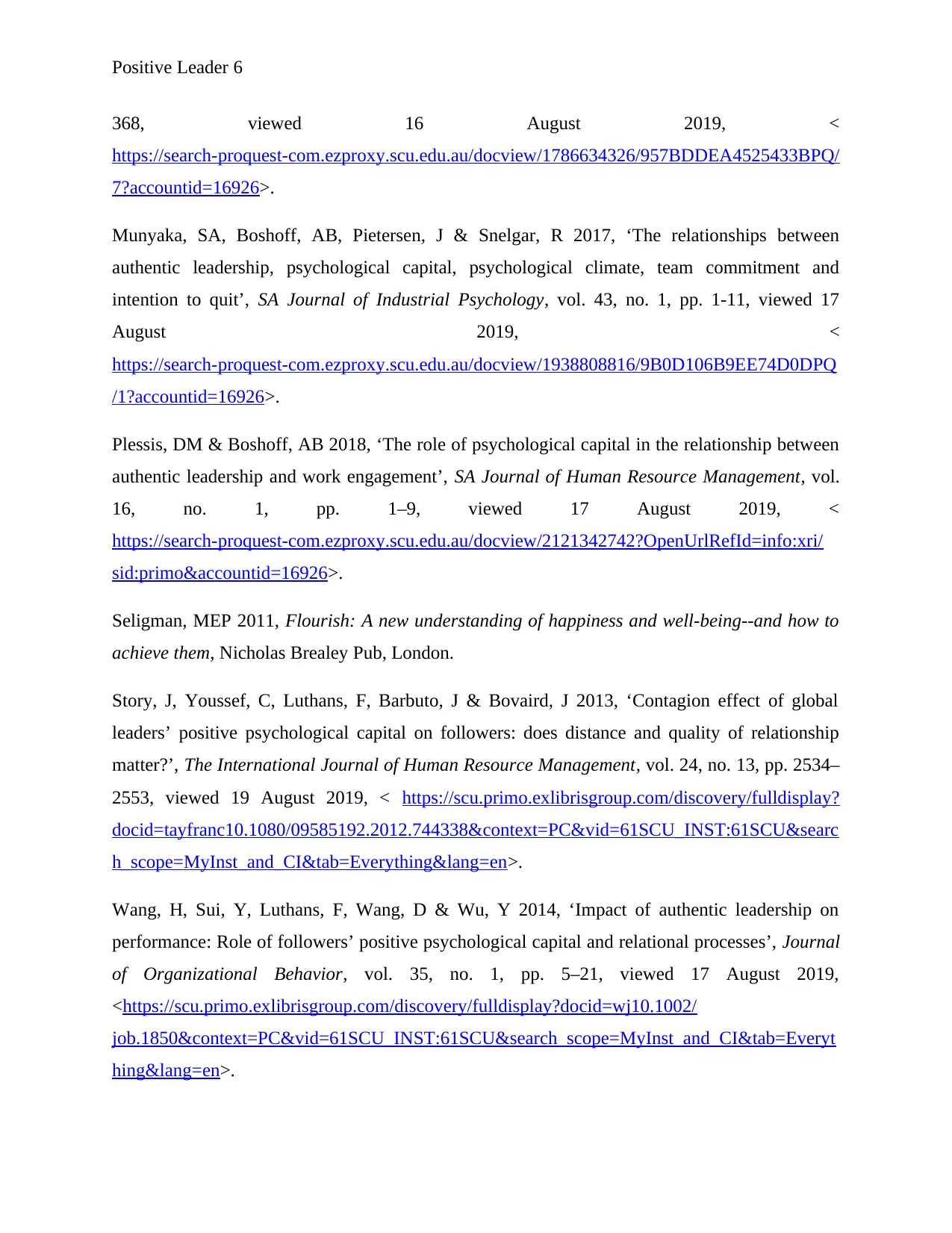
Positive Leader 6
368, viewed 16 August 2019, <
https://search-proquest-com.ezproxy.scu.edu.au/docview/1786634326/957BDDEA4525433BPQ/
7?accountid=16926>.
Munyaka, SA, Boshoff, AB, Pietersen, J & Snelgar, R 2017, ‘The relationships between
authentic leadership, psychological capital, psychological climate, team commitment and
intention to quit’, SA Journal of Industrial Psychology, vol. 43, no. 1, pp. 1-11, viewed 17
August 2019, <
https://search-proquest-com.ezproxy.scu.edu.au/docview/1938808816/9B0D106B9EE74D0DPQ
/1?accountid=16926>.
Plessis, DM & Boshoff, AB 2018, ‘The role of psychological capital in the relationship between
authentic leadership and work engagement’, SA Journal of Human Resource Management, vol.
16, no. 1, pp. 1–9, viewed 17 August 2019, <
https://search-proquest-com.ezproxy.scu.edu.au/docview/2121342742?OpenUrlRefId=info:xri/
sid:primo&accountid=16926>.
Seligman, MEP 2011, Flourish: A new understanding of happiness and well-being--and how to
achieve them, Nicholas Brealey Pub, London.
Story, J, Youssef, C, Luthans, F, Barbuto, J & Bovaird, J 2013, ‘Contagion effect of global
leaders’ positive psychological capital on followers: does distance and quality of relationship
matter?’, The International Journal of Human Resource Management, vol. 24, no. 13, pp. 2534–
2553, viewed 19 August 2019, < https://scu.primo.exlibrisgroup.com/discovery/fulldisplay?
docid=tayfranc10.1080/09585192.2012.744338&context=PC&vid=61SCU_INST:61SCU&searc
h_scope=MyInst_and_CI&tab=Everything&lang=en>.
Wang, H, Sui, Y, Luthans, F, Wang, D & Wu, Y 2014, ‘Impact of authentic leadership on
performance: Role of followers’ positive psychological capital and relational processes’, Journal
of Organizational Behavior, vol. 35, no. 1, pp. 5–21, viewed 17 August 2019,
<https://scu.primo.exlibrisgroup.com/discovery/fulldisplay?docid=wj10.1002/
job.1850&context=PC&vid=61SCU_INST:61SCU&search_scope=MyInst_and_CI&tab=Everyt
hing&lang=en>.
368, viewed 16 August 2019, <
https://search-proquest-com.ezproxy.scu.edu.au/docview/1786634326/957BDDEA4525433BPQ/
7?accountid=16926>.
Munyaka, SA, Boshoff, AB, Pietersen, J & Snelgar, R 2017, ‘The relationships between
authentic leadership, psychological capital, psychological climate, team commitment and
intention to quit’, SA Journal of Industrial Psychology, vol. 43, no. 1, pp. 1-11, viewed 17
August 2019, <
https://search-proquest-com.ezproxy.scu.edu.au/docview/1938808816/9B0D106B9EE74D0DPQ
/1?accountid=16926>.
Plessis, DM & Boshoff, AB 2018, ‘The role of psychological capital in the relationship between
authentic leadership and work engagement’, SA Journal of Human Resource Management, vol.
16, no. 1, pp. 1–9, viewed 17 August 2019, <
https://search-proquest-com.ezproxy.scu.edu.au/docview/2121342742?OpenUrlRefId=info:xri/
sid:primo&accountid=16926>.
Seligman, MEP 2011, Flourish: A new understanding of happiness and well-being--and how to
achieve them, Nicholas Brealey Pub, London.
Story, J, Youssef, C, Luthans, F, Barbuto, J & Bovaird, J 2013, ‘Contagion effect of global
leaders’ positive psychological capital on followers: does distance and quality of relationship
matter?’, The International Journal of Human Resource Management, vol. 24, no. 13, pp. 2534–
2553, viewed 19 August 2019, < https://scu.primo.exlibrisgroup.com/discovery/fulldisplay?
docid=tayfranc10.1080/09585192.2012.744338&context=PC&vid=61SCU_INST:61SCU&searc
h_scope=MyInst_and_CI&tab=Everything&lang=en>.
Wang, H, Sui, Y, Luthans, F, Wang, D & Wu, Y 2014, ‘Impact of authentic leadership on
performance: Role of followers’ positive psychological capital and relational processes’, Journal
of Organizational Behavior, vol. 35, no. 1, pp. 5–21, viewed 17 August 2019,
<https://scu.primo.exlibrisgroup.com/discovery/fulldisplay?docid=wj10.1002/
job.1850&context=PC&vid=61SCU_INST:61SCU&search_scope=MyInst_and_CI&tab=Everyt
hing&lang=en>.
Paraphrase This Document
Need a fresh take? Get an instant paraphrase of this document with our AI Paraphraser
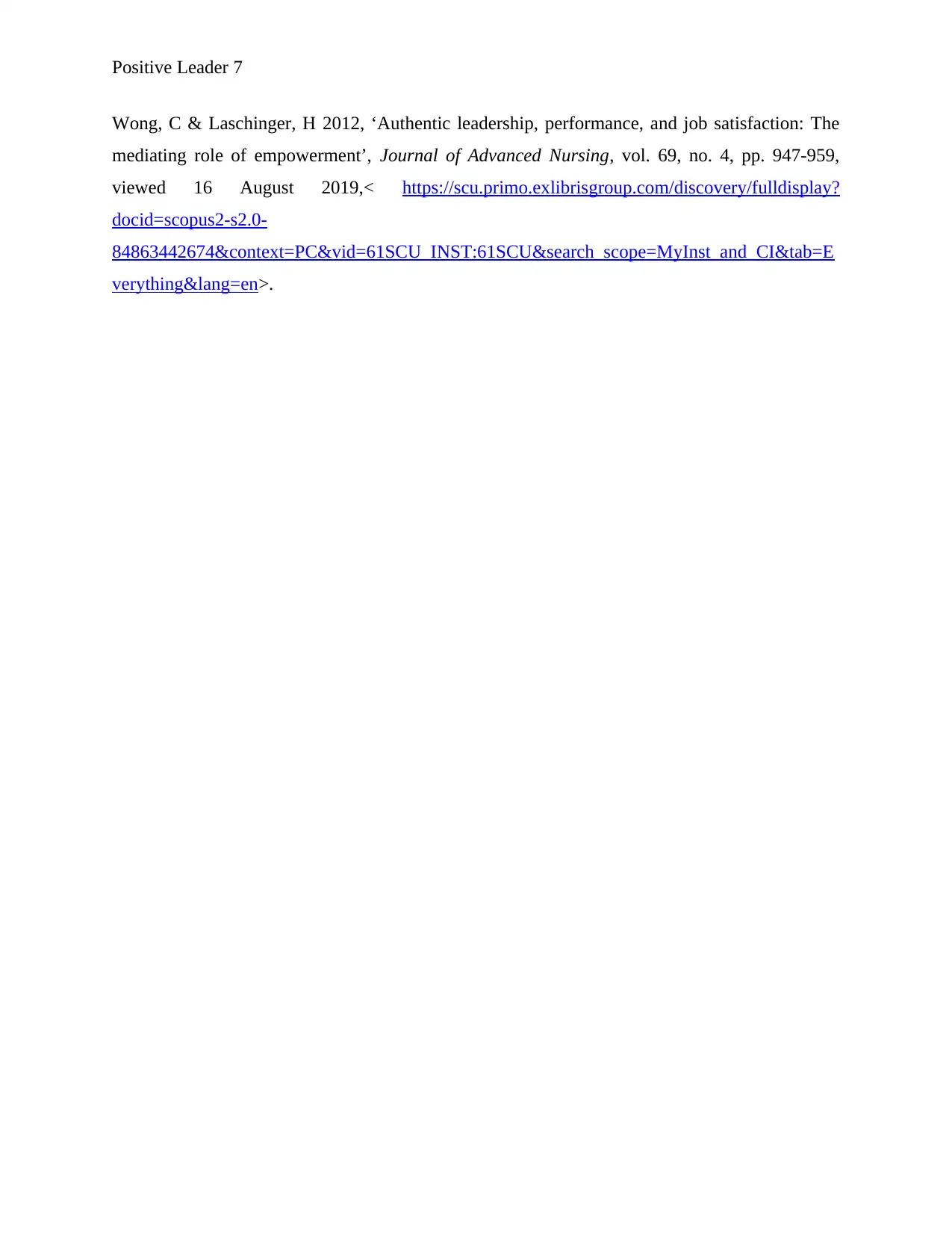
Positive Leader 7
Wong, C & Laschinger, H 2012, ‘Authentic leadership, performance, and job satisfaction: The
mediating role of empowerment’, Journal of Advanced Nursing, vol. 69, no. 4, pp. 947-959,
viewed 16 August 2019,< https://scu.primo.exlibrisgroup.com/discovery/fulldisplay?
docid=scopus2-s2.0-
84863442674&context=PC&vid=61SCU_INST:61SCU&search_scope=MyInst_and_CI&tab=E
verything&lang=en>.
Wong, C & Laschinger, H 2012, ‘Authentic leadership, performance, and job satisfaction: The
mediating role of empowerment’, Journal of Advanced Nursing, vol. 69, no. 4, pp. 947-959,
viewed 16 August 2019,< https://scu.primo.exlibrisgroup.com/discovery/fulldisplay?
docid=scopus2-s2.0-
84863442674&context=PC&vid=61SCU_INST:61SCU&search_scope=MyInst_and_CI&tab=E
verything&lang=en>.
1 out of 8
Related Documents
Your All-in-One AI-Powered Toolkit for Academic Success.
+13062052269
info@desklib.com
Available 24*7 on WhatsApp / Email
![[object Object]](/_next/static/media/star-bottom.7253800d.svg)
Unlock your academic potential
Copyright © 2020–2025 A2Z Services. All Rights Reserved. Developed and managed by ZUCOL.





